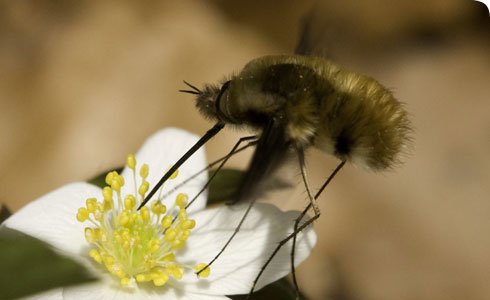Biology
The adult has:
- a long proboscis
- a dark brown front margin to the wings that’s 6-12.5mm in length
- wings 9-14mm in length
- long legs
Females will flick eggs into the tunnels of solitary bees or in a habitat that is suitable for the host species. There are several host species, particularly digging bees such as Andrena sp. (Boesi et al, 2009, Paxton and Pohl, 1999).
Once in the tunnel, the egg hatches and the worm-like maggot crawls into an open host cell. It remains inactive until the host larva is about to pupate.
The bee-fly larva then becomes a maggot-like ectoparasite and attaches to the outside of the host, sucking out the body fluids (Oldroyd, 1964, Stubbs and Drake 2001). This is called hypermetamorphosis - the different larval instars are present in 2 or more different forms.
The pupal stage is variable, but some will overwinter, with records in Britain and Sweden recording a quiescent stage that may last for 2 years (Stubbs and Drake 2001, Paxton and Pohl, 1999).
Members of the genus Bombylius fly early in the year and are found from April to June in Europe, North America and some parts of Asia.
Temperature determines the distribution and emergence of B. major and it will not fly in temperatures less than 17ºC.
The adults exhibit courtship rituals - males hover at height and exhibit territorial behaviour which includes darting at rival males and spinning at females.
Toolbox
Follow the Curator of Diptera's blog

What happens behind the scenes in the Museum's Life Sciences Department? Curator Erica McAlister has about 30,000 species of fly to look after, and fieldwork trips at home and abroad. Her life is never dull!
Follow the blog